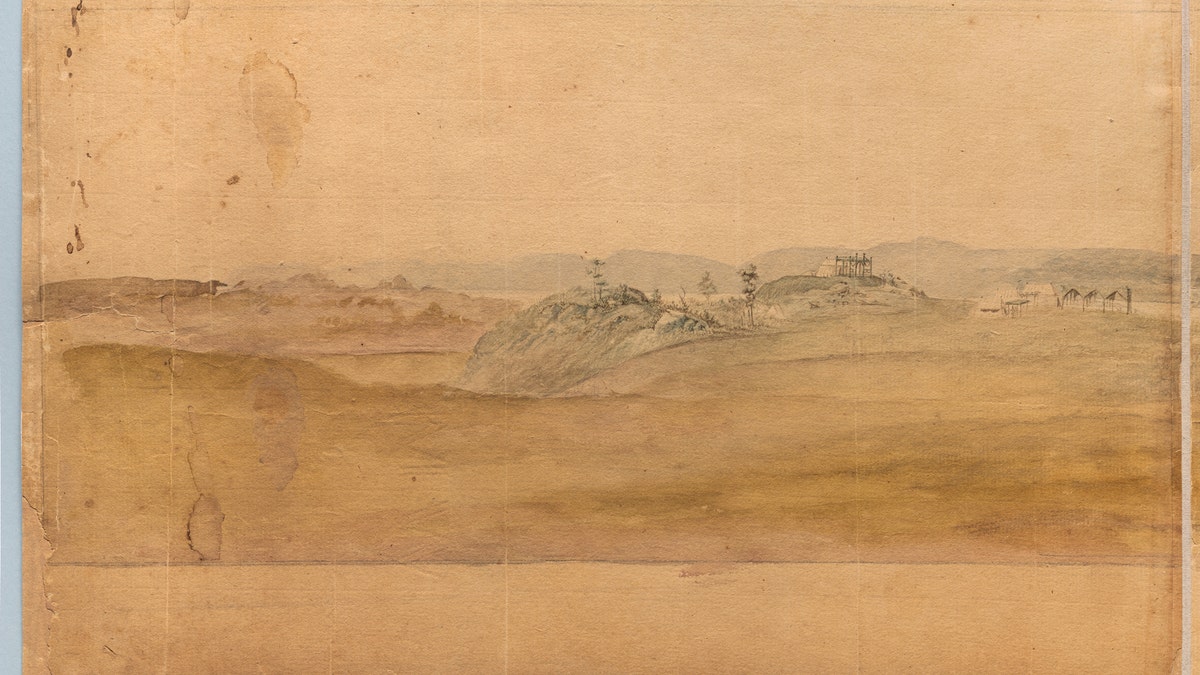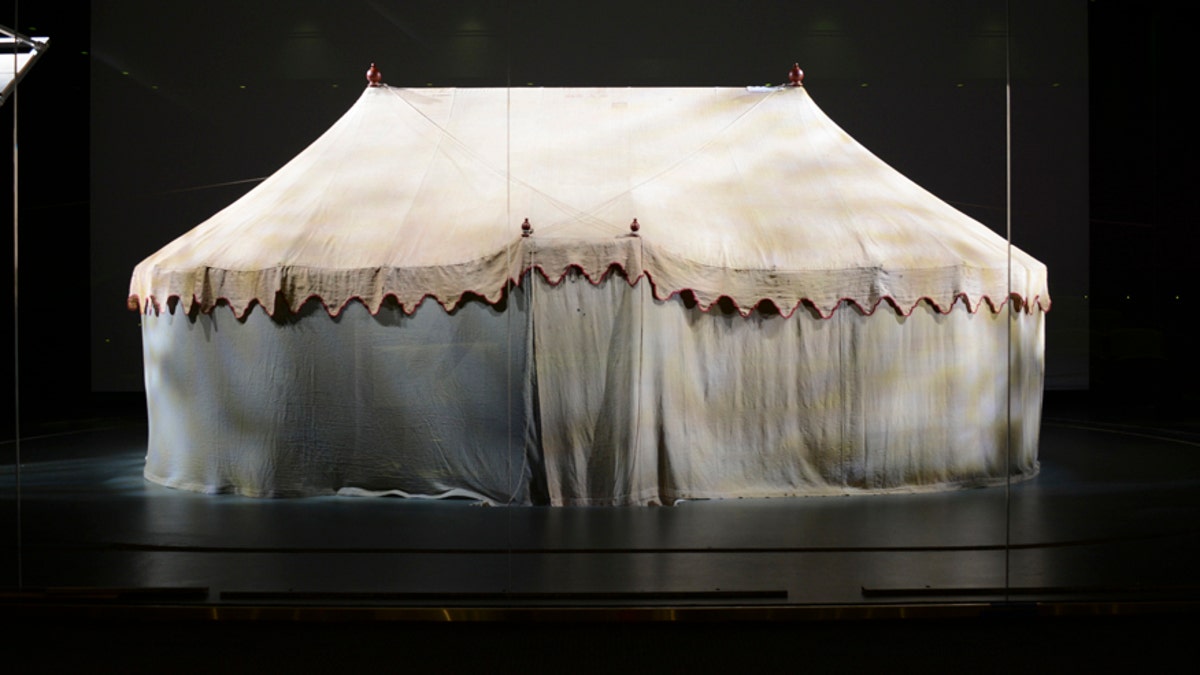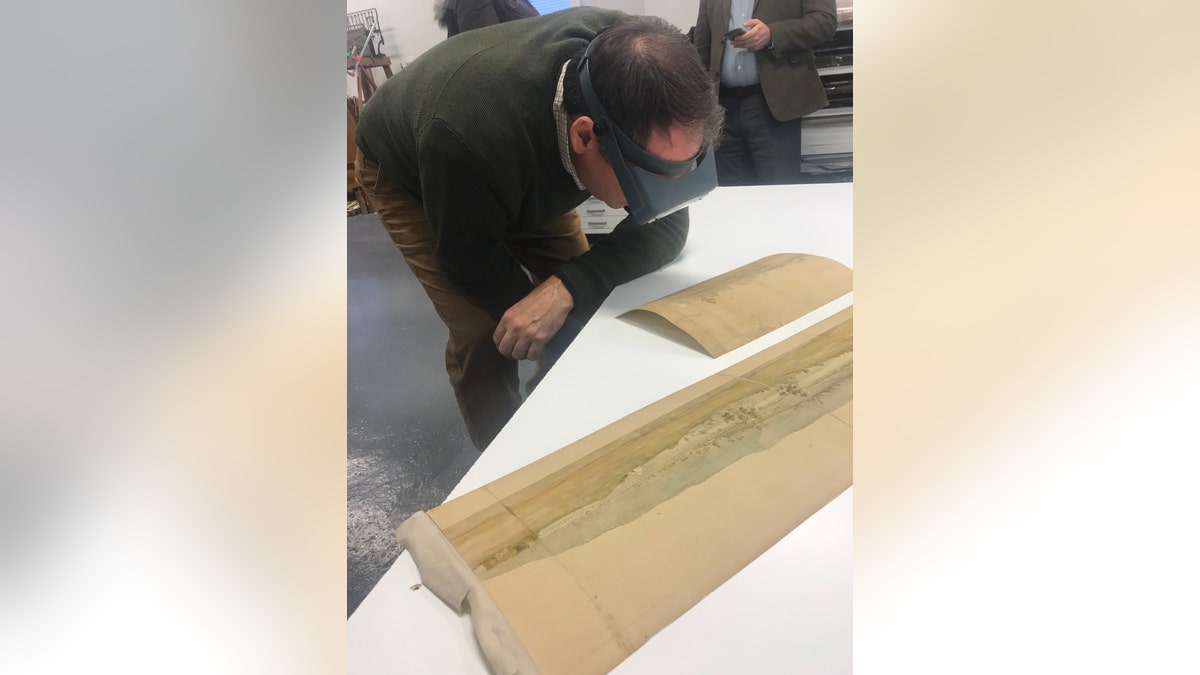
Close-up detail of the watercolor depicting George Washington's field tent (Courtesy of the Museum of the American Revolution) and portrait of George Washington by Joseph Wright, 1784. (Courtesy of the Philadelphia History Museum at the Atwater Kent, the Historical Society of Pennsylvania Collection)
A recently discovered 235-year-old panoramic painting has revealed the only known wartime depiction of George Washington’s Revolutionary War field tent.
The seven-foot painting, which was recently purchased at auction by the Museum of the American Revolution, shows the Continental Army’s encampment at Verplanck’s Point, New York, in the fall of 1782.
The previously unidentified painting was spotted by curators from the Museum, who purchased it at Heritage Auctions in May.
'THE FIRST OVAL OFFICE': MUSEUM WILL SHOWCASE WASHINGTON’S REVOLUTIONARY WAR TENT
The actual tent is one of the key artifacts at the Museum in Philadelphia’s Old City, where it is displayed in a dedicated theater. Described as ‘the first Oval Office,’ the canvas tent was Washington’s Command Center throughout the Revolutionary War. The tent went on display when the Museum opened its doors in April 2017.

Close-up of tent detail in Verplancks Point watercolor (Courtesy of the Museum of the American Revolution)
A spokeswoman for the Museum told Fox News that the Museum paid around $12,000 for the painting.
“My heart leapt into my throat when I realized what this painting was,” said Dr. R. Scott Stephenson, the Museum’s vice president of collections, exhibitions and programming, in a statement. “For it to appear just months after unveiling Washington’s original tent is an astonishing coincidence.”
RARE REVOLUTIONARY WAR SWORD TO GO ON DISPLAY FOR THE FIRST TIME
The painting shows hundreds of military tents amid the rolling landscape of the Hudson Valley, with Washington’s tent perched upon a hilltop.

General George Washington's Revolutionary War field tent on display at the Museum of the American Revolution (Courtesy of the Museum of the American Revolution).
When it was auctioned, the work was not attributed to an artist. However, experts at the Museum believe that the painting is the work of Pierre Charles L’Enfant, the French-born military engineer who served in the Revolutionary War and is best known for designing the layout of Washington D.C.
Curators traced the watercolor’s provenance to the Maryland family that sheltered L’Enfant before he died aged 70 in 1825. The museum notes that the family’s descendants donated a panoramic painting by L’Enfant of West Point, New York, to the Library of Congress in 1920. By comparing details in the depictions of West Point and Verplanck’s Point, they realized that the latter was also likely the work of L’Enfant.
FROM ROYAL STATUE TO REVOLUTIONARY WAR BATTLE: THE AMAZING JOURNEY OF 'MELTED MAJESTY' MUSKET BALL
The painting showing George Washington’s tent will go on display from Jan. 13 to Feb. 19, 2018.

Scott Stephenson examines the watercolor (Courtesy of the Museum of the American Revolution)
The Library of Congress will also loan the West Point painting to the Museum of the American Revolution to display alongside the watercolor of Verplanck’s Point.
The discovery of Revolutionary War era artifacts offers a fascinating glimpse into the events that shaped America. A storied Revolutionary War musket ball that was melted from a famously toppled statue of King George III, for example, went on display at the Museum of the American Revolution earlier this year. The Museum also recently displayed George Washington’s sash from the Revolutionary War.
SOLDIER'S FAITH: RARE BIBLE CARRIED AT THE BATTLE OF BUNKER HILL HAS MOVING INSCRIPTIONS
An extremely rare silver-hilted sword used by an American officer during the Revolutionary War is set to go on display for the first time at the Museum next year.

General George Washington's Revolutionary War field tent on display at the Museum of the American Revolution (Courtesy of the Museum of the American Revolution).
In August, a Revolutionary War-era knife was unearthed during an archaeological dig at Colonial Michilimackinac in Mackinaw City, Michigan, the latest in a series of amazing finds at the site.
The following month, archaeologists in Boston discovered a centuries-old outhouse that may be linked to the family of Patriot Paul Revere.
Follow James Rogers on Twitter @jamesjrogers